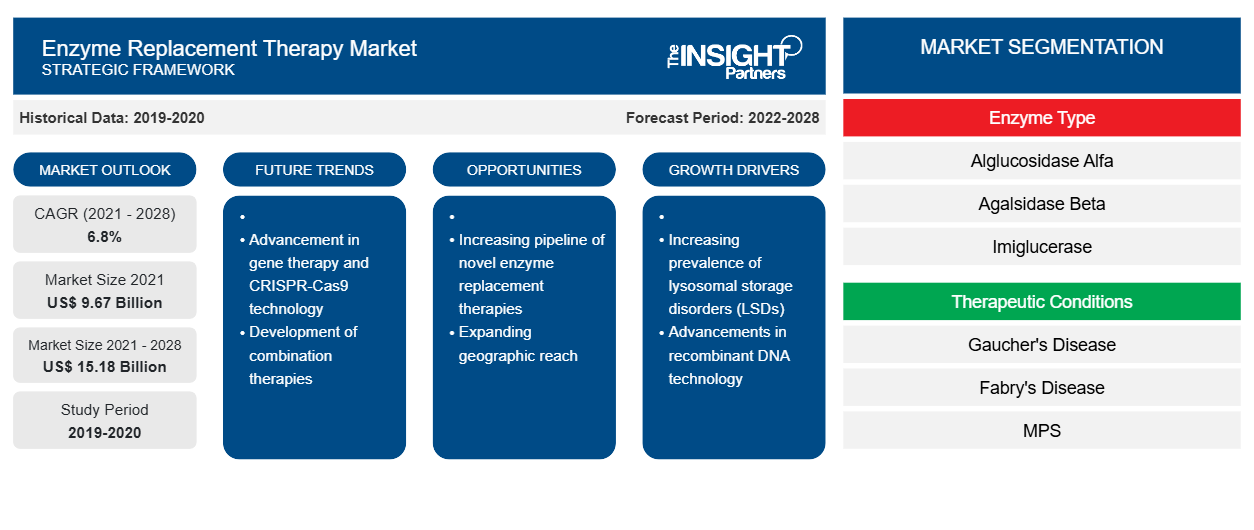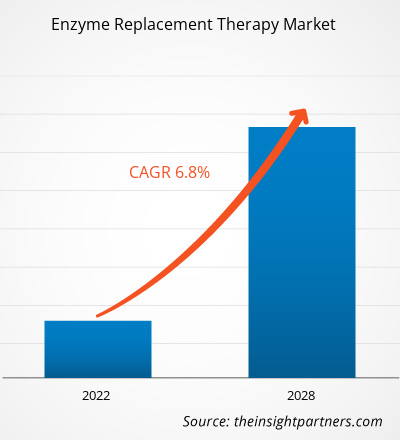酶替代疗法市场预计将从 2021 年的 96.7339 亿美元增长到 2028 年的 151.847 亿美元;预计2022 年至 2028 年的复合年增长率为 6.8%。
酶替代疗法 ( ERT ) 是利用具有酶活性的酶或蛋白质来治疗先天性酶缺乏症。动物、人类和重组工程酶是治疗所需的几种酶来源。这种疗法通常应用于罕见和溶酶体贮积症,包括庞贝氏症、法布里病、戈谢病、泰-萨克斯病和胡尔勒综合征。最常见的ERT方法是静脉输液,其中替代酶通过控制的液体滴注直接注入血液。全球酶替代疗法市场的增长 归因于溶酶体贮积症 ( LSD ) 患病率的上升以及孤儿药指定的药物的快速监管批准和其他营销优势。然而,市场参与者之间的激烈竞争阻碍了市场增长。
报告对全球酶替代疗法市场提供了见解和深入分析,强调了各种参数,包括市场趋势、技术进步、市场动态和全球主要市场参与者的竞争格局分析。它还包括 COVID-19 大流行对所有地区市场的影响。由于 COVID-19 大流行,许多卫生当局将重点放在与大流行相关的护理上。此外,由于医院服务不足以应对 COVID-19 患者的负担,许多需要酶替代疗法的患者在 2020 年 3 月错过了输液。需要ERT的患者声称在住院期间或对药物供应感到焦虑。此外,研究显示,一些患者患有抑郁症,焦虑程度加剧。因此,在 COVID-19 大流行期间,预定的酶替代疗法 ( ERT ) 疗程被打乱,对市场产生负面影响。
定制此报告以满足您的需求
您可以免费定制任何报告,包括本报告的部分内容、国家级分析、Excel 数据包,以及为初创企业和大学提供优惠和折扣
- 获取此报告的关键市场趋势。这个免费样品将包括数据分析,从市场趋势到估计和预测。
基于地理位置的洞察
根据地域划分,全球酶替代疗法市场分为北美(美国、加拿大和墨西哥)、欧洲(法国、德国、英国、西班牙、意大利和欧洲其他地区)、亚太地区(中国、印度、日本、澳大利亚、韩国和亚太地区其他地区)、中东和非洲(沙特阿拉伯、阿联酋、南非和中东和非洲其他地区)以及南美洲和中美洲(巴西、阿根廷和南美洲和中美洲其他地区)。
市场洞察
溶酶体贮积症 ( LSD )患病率上升
溶酶体是一种含有消化酶的膜结合细胞器。溶酶体是大分子分解代谢、循环和信号传导的关键细胞枢纽。这些功能中的任何缺陷都会导致大分子在溶酶体中积累或储存,从而导致细胞损伤。溶酶体贮积症 ( LSD )的主要原因是负责编码溶酶体酶的基因发生突变。此外,LSD被描述为一种先天性代谢错误,导致酶缺失或不足。与成人相比,婴儿和儿童遭受的痛苦更严重,因为儿童可以从父母一方或双方遗传到有缺陷的基因。然而,自过去十年以来,这种模式一直在发生变化,LSD在成人中更为常见
此外,LSD大约有 70 种疾病,包括戈谢病、尼曼-匹克病、法布里病、泰-萨克斯病、粘多糖病( MPS ) 和庞贝病。这些疾病单独来看很少见,但总体上却非常普遍,每 5,000 个活产婴儿中就有 1 个患有此病。许多国家进行了调查以了解患病模式,总体患病率正在上升。例如,《柳叶刀区域卫生》上发表的一项研究题为“2009 年至 2020 年澳大利亚溶酶体贮积症患病率”。该研究揭示了以下结果:
- 澳大利亚人口的发病率是 1996 年报告的发病率(每 7,700 个活产婴儿中有 1 个)的 1.6 倍(每 4,800 个活产婴儿中有 1 个)。
- 法布里病最为常见,占所有诊断的 34%(截至 2020 年)。
- 成年人服用LSD 的几率比儿童高
因此, LSD的流行率不断上升以及治疗该疾病的疗法有限,正在推动全球酶替代疗法市场的增长
基于酶类型的见解
根据酶类型,全球酶替代疗法市场细分为阿糖苷酶α、阿加糖苷酶β、伊米苷酶、艾杜尔硫酸酶、加拉硫酸酶、维拉苷酶α和其他酶。2021 年,其他酶细分市场占据最大市场份额。预计同一细分市场将在 2022 年至 2028 年期间实现市场最高复合年增长率。
基于治疗条件的见解
根据治疗条件,全球酶替代疗法市场细分为戈谢氏病、法布里病、庞贝氏病、严重联合免疫缺陷症 (SCID)、骨髓增生异常综合征 (MPS) 和其他治疗条件。戈谢氏病细分市场在 2021 年占据最大市场份额,预计在预测期内将实现最高复合年增长率。
基于给药途径的见解
根据给药途径,全球酶替代疗法市场分为肠外和口服。肠外部分在 2021 年占据了更大的市场份额,预计在预测期内将实现更高的复合年增长率。
酶替代疗法市场区域洞察
Insight Partners 的分析师已详尽解释了预测期内影响酶替代疗法市场的区域趋势和因素。本节还讨论了北美、欧洲、亚太地区、中东和非洲以及南美和中美洲的酶替代疗法市场细分和地理位置。

- 获取酶替代疗法市场的区域特定数据
酶替代疗法市场报告范围
| 报告属性 | 细节 |
|---|---|
| 2021 年市场规模 | 96.7 亿美元 |
| 2028 年市场规模 | 151.8亿美元 |
| 全球复合年增长率(2021 - 2028) | 6.8% |
| 史料 | 2019-2020 |
| 预测期 | 2022-2028 |
| 涵盖的领域 | 按酶类型
|
| 覆盖地区和国家 | 北美
|
| 市场领导者和主要公司简介 |
|
酶替代疗法市场参与者密度:了解其对业务动态的影响
酶替代疗法市场正在快速增长,这得益于终端用户需求的不断增长,而这些需求又源于消费者偏好的不断变化、技术进步以及对产品优势的认识不断提高等因素。随着需求的增加,企业正在扩大其产品范围,进行创新以满足消费者的需求,并利用新兴趋势,从而进一步推动市场增长。
市场参与者密度是指在特定市场或行业内运营的企业或公司的分布情况。它表明在给定市场空间中,相对于其规模或总市场价值,有多少竞争对手(市场参与者)存在。
在酶替代疗法市场运营的主要公司有:
- 赛诺菲
- BioMarin 制药公司
- 武田药品工业株式会社
- 艾伯维公司(AbbVie Inc.)
- 杨森制药(强生服务公司)
免责声明:上面列出的公司没有按照任何特定顺序排列。

- 了解酶替代疗法市场的主要参与者概况
基于最终用户的洞察
根据最终用户,全球酶替代疗法市场分为医院、输液中心和其他。医院部分在 2021 年占据了最大的市场份额。然而,输液中心部分预计在预测期内将实现最高的复合年增长率。
全球酶替代疗法市场参与者采用有机策略,包括产品发布和扩张,以扩大其全球足迹和产品组合并满足不断增长的需求。为市场做出贡献的一些主要参与者是武田制药有限公司;赛诺菲公司;艾伯维公司;BioMarin Pharmaceutical Inc.;Amicus Therapeutics;Alexion Pharmaceuticals, Inc.(阿斯利康);杨森制药(强生服务公司);Recordati SpA;辉瑞公司;和 CHIESI Farmaceutici SpA
- 历史分析(2 年)、基准年、预测(7 年)及复合年增长率
- PEST 和 SWOT 分析
- 市场规模价值/数量 - 全球、区域、国家
- 行业和竞争格局
- Excel 数据集



Report Coverage
Revenue forecast, Company Analysis, Industry landscape, Growth factors, and Trends

Segment Covered
This text is related
to segments covered.

Regional Scope
North America, Europe, Asia Pacific, Middle East & Africa, South & Central America

Country Scope
This text is related
to country scope.
常见问题
Global enzyme replacement therapy market is segmented by region into North America, Europe, Asia Pacific, Middle East & Africa, and South & Central America. In North America, the U.S. is the largest market for enzyme replacement therapy market. A rise in the prevalence of lysosomal storage diseases such as Gaucher’s, Pompe’s, and Fabry’s diseases, increasing regulatory approval, favorable regulatory support by the government, and the availability of various ERT products will drive enzyme replacement therapy market growth in North America. However, the growing government funding for rare disease treatment, increasing clinical trials, an increasing number of product approvals, and expanding partnerships among key players are the key factors responsible for the Asia-Pacific regional growth of the enzyme replacement therapy market accounting fastest growth in the region during the coming years.
The hospitals segment dominated the global enzyme replacement therapy market and accounted for the largest market share of 49.00% in 2021.
Takeda Pharmaceutical Company Limited, Sanofi, AbbVie Inc., BioMarin Pharmaceutical Inc., Amicus Therapeutics, Alexion Pharmaceuticals, Inc.(AstraZeneca), Janssen Pharmaceuticals (Johnson & Johnson Services, Inc.), Recordati S.p.A., Pfizer Inc., and CHIESI Farmaceutici S.p.A. are among the leading companies operating in the enzyme replacement therapy market
Based on route of administration, parenteral route of administration segment took the forefront lead in the worldwide market by accounting largest share in 2021 and is expected to continue to do so till the forecast period.
Based on therapeutic conditions, Gaucher's disease segment took the forefront lead in the worldwide market by accounting largest share in 2021 and is expected to continue to do so till the forecast period.
Based on enzyme type, other enzymes segment took the forefront lead in the worldwide market by accounting largest share in 2021 and is expected to continue to do so till the forecast period. Other enzymes include taliglucerase, laronidase, agalsidase alfa, eliglustat, cipaglucosidase alfa, miglustat, elosulfase alfa, elapegademase, velmanase alfa, pancreatic enzymes, pegademase, sebelipase alfa, cerliponase alfa, among others.
Enzyme replacement therapy (ERT) is a treatment that replaces enzymes that are not present or are deficient in the body. This is usually done by giving the patient an intravenous (IV) infusion or oral solution in which the enzyme is present. ERT is available for various lysosomal storage diseases which include Fabry’s disease, Gaucher’s disease, Pompe’s disease, MPS, and others. The ERT only increases the concentration of the enzymes which is lacking in the patient body and it does not correct any underlying genetic defect. ERT has also been used to treat patients with severe combined immunodeficiency (SCID) resulting from an adenosine deaminase deficiency (ADA-SCID).
Rising prevalence of lysosomal storage diseases (LSDS) and rapid regulatory approval with other benefits for drug with orphan drug designation are the most significant factors responsible for the overall market growth.
Trends and growth analysis reports related to Life Sciences : READ MORE..
The List of Companies - Enzyme Replacement Therapy Market
- Sanofi
- BioMarin Pharmaceutical Inc.
- Takeda Pharmaceutical Company Limited
- AbbVie Inc.
- Janssen Pharmaceuticals (Johnson & Johnson Services, Inc.)
- Alexion Pharmaceuticals, Inc (AstraZeneca)
- Amicus Therapeutics
- Recordati S.p.A.
- CHIESI Farmaceutici S.p.A.
- Pfizer Inc.
The Insight Partners performs research in 4 major stages: Data Collection & Secondary Research, Primary Research, Data Analysis and Data Triangulation & Final Review.
- Data Collection and Secondary Research:
As a market research and consulting firm operating from a decade, we have published and advised several client across the globe. First step for any study will start with an assessment of currently available data and insights from existing reports. Further, historical and current market information is collected from Investor Presentations, Annual Reports, SEC Filings, etc., and other information related to company’s performance and market positioning are gathered from Paid Databases (Factiva, Hoovers, and Reuters) and various other publications available in public domain.
Several associations trade associates, technical forums, institutes, societies and organization are accessed to gain technical as well as market related insights through their publications such as research papers, blogs and press releases related to the studies are referred to get cues about the market. Further, white papers, journals, magazines, and other news articles published in last 3 years are scrutinized and analyzed to understand the current market trends.
- Primary Research:
The primarily interview analysis comprise of data obtained from industry participants interview and answers to survey questions gathered by in-house primary team.
For primary research, interviews are conducted with industry experts/CEOs/Marketing Managers/VPs/Subject Matter Experts from both demand and supply side to get a 360-degree view of the market. The primary team conducts several interviews based on the complexity of the markets to understand the various market trends and dynamics which makes research more credible and precise.
A typical research interview fulfils the following functions:
- Provides first-hand information on the market size, market trends, growth trends, competitive landscape, and outlook
- Validates and strengthens in-house secondary research findings
- Develops the analysis team’s expertise and market understanding
Primary research involves email interactions and telephone interviews for each market, category, segment, and sub-segment across geographies. The participants who typically take part in such a process include, but are not limited to:
- Industry participants: VPs, business development managers, market intelligence managers and national sales managers
- Outside experts: Valuation experts, research analysts and key opinion leaders specializing in the electronics and semiconductor industry.
Below is the breakup of our primary respondents by company, designation, and region:

Once we receive the confirmation from primary research sources or primary respondents, we finalize the base year market estimation and forecast the data as per the macroeconomic and microeconomic factors assessed during data collection.
- Data Analysis:
Once data is validated through both secondary as well as primary respondents, we finalize the market estimations by hypothesis formulation and factor analysis at regional and country level.
- Macro-Economic Factor Analysis:
We analyse macroeconomic indicators such the gross domestic product (GDP), increase in the demand for goods and services across industries, technological advancement, regional economic growth, governmental policies, the influence of COVID-19, PEST analysis, and other aspects. This analysis aids in setting benchmarks for various nations/regions and approximating market splits. Additionally, the general trend of the aforementioned components aid in determining the market's development possibilities.
- Country Level Data:
Various factors that are especially aligned to the country are taken into account to determine the market size for a certain area and country, including the presence of vendors, such as headquarters and offices, the country's GDP, demand patterns, and industry growth. To comprehend the market dynamics for the nation, a number of growth variables, inhibitors, application areas, and current market trends are researched. The aforementioned elements aid in determining the country's overall market's growth potential.
- Company Profile:
The “Table of Contents” is formulated by listing and analyzing more than 25 - 30 companies operating in the market ecosystem across geographies. However, we profile only 10 companies as a standard practice in our syndicate reports. These 10 companies comprise leading, emerging, and regional players. Nonetheless, our analysis is not restricted to the 10 listed companies, we also analyze other companies present in the market to develop a holistic view and understand the prevailing trends. The “Company Profiles” section in the report covers key facts, business description, products & services, financial information, SWOT analysis, and key developments. The financial information presented is extracted from the annual reports and official documents of the publicly listed companies. Upon collecting the information for the sections of respective companies, we verify them via various primary sources and then compile the data in respective company profiles. The company level information helps us in deriving the base number as well as in forecasting the market size.
- Developing Base Number:
Aggregation of sales statistics (2020-2022) and macro-economic factor, and other secondary and primary research insights are utilized to arrive at base number and related market shares for 2022. The data gaps are identified in this step and relevant market data is analyzed, collected from paid primary interviews or databases. On finalizing the base year market size, forecasts are developed on the basis of macro-economic, industry and market growth factors and company level analysis.
- Data Triangulation and Final Review:
The market findings and base year market size calculations are validated from supply as well as demand side. Demand side validations are based on macro-economic factor analysis and benchmarks for respective regions and countries. In case of supply side validations, revenues of major companies are estimated (in case not available) based on industry benchmark, approximate number of employees, product portfolio, and primary interviews revenues are gathered. Further revenue from target product/service segment is assessed to avoid overshooting of market statistics. In case of heavy deviations between supply and demand side values, all thes steps are repeated to achieve synchronization.
We follow an iterative model, wherein we share our research findings with Subject Matter Experts (SME’s) and Key Opinion Leaders (KOLs) until consensus view of the market is not formulated – this model negates any drastic deviation in the opinions of experts. Only validated and universally acceptable research findings are quoted in our reports.
We have important check points that we use to validate our research findings – which we call – data triangulation, where we validate the information, we generate from secondary sources with primary interviews and then we re-validate with our internal data bases and Subject matter experts. This comprehensive model enables us to deliver high quality, reliable data in shortest possible time.


 获取此报告的免费样本
获取此报告的免费样本